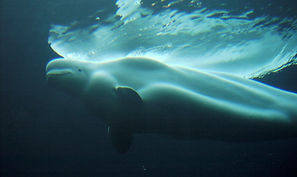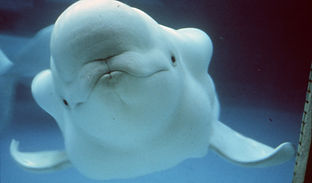

Beluga
Listen beluga sound:



White Whale or Beluga
The beluga or white whale (Delphinapterus leucas) is an Arctic and sub-Arctic species of cetacean. It is one of the two members of the family Monodontidae, along with the narwhal. In 1776, Peter Simon Pallas was the first to describe the beluga.
This marine mammal is commonly referred to simply as the beluga or sea canary due to its high-pitched twitter. It is up to 5 meters in length and an unmistakable all-white color with a distinctive protuberance on the head. From a conservation perspective, the beluga is considered "near threatened" by the International Union for Conservation of Nature; however the subpopulation from the Cook Inlet in Alaska is considered critically endangered and is under the protection of the United States' Endangered Species Act.
Male belugas are larger than females. Males can reach 5.5 meters long, while females grow to 4.1 meters. Males weigh between 1100 and 1600 kilograms while females weigh between 700 and 1200 kilograms. The adult beluga is rarely mistaken for another species, because it is completely white or whitish-gray in color. Its head is unlike that of any other cetacean. Like most toothed whales it has a melon — an oily, fatty tissue lump found at the center of the forehead. The beluga's melon is extremely bulbous and even malleable. The beluga is able to change the shape of its head by blowing air around its sinuses. Unlike many dolphins and whales, the vertebrae in the neck are not fused together, allowing the animal to turn its head laterally. The rostrum has about 8 to 10 teeth on each side of the jaw and a total of 34 to 40 teeth.
Belugas have a dorsal ridge, rather than a dorsal fin. The absence of the dorsal fin is reflected in the genus name of the species — apterus the Greek word for "wingless." The evolutionary preference for a dorsal ridge rather than a fin is believed to be an adaptation to under-ice conditions, or possibly as a way of preserving heat. As in other cetaceans, the thyroid gland is relatively large compared to terrestrial mammals (proportionally three times as large as a horse's thyroid) and may help to maintain higher metabolism during the summer estuarine occupations.
Its body is round, particularly when well-fed, and tapers less smoothly to the head than the tail. The sudden tapering to the base of her neck gives it the appearance of shoulders, unique among cetaceans. The tail fin grows and becomes increasingly and ornately curved as the animal ages. The flippers are broad and short — making them almost square-shaped.
The beluga inhabits a discontinuous circumpolar distribution in Arctic and sub-Arctic waters ranging from 50 ° N to 80 ° N, particularly along the coasts of Alaska, Canada, Greenland, and Russia. The southernmost extent of their range includes isolated populations in the St. Lawrence River estuary and the Saguenay fjord, around the village of Tadoussac, Quebec, in the Atlantic and the Amur River delta, the Shantar Islands and the waters surrounding Sakhalin Island in the Sea of Okhotsk.
Beluga may also find air pockets trapped under the ice. The beluga's ability to find the thin slivers of open water within a dense ice pack that may cover more than 96% of the surface mystifies scientists. Its echo-location capabilities are highly adapted to the sub-ice sea's peculiar acoustics and it has been suggested that belugas can sense open water through echo-location.
Belugas are highly sociable. Belugas can be playful — they may spit at humans or other whales. It is not unusual for an aquarium handler to be drenched by one of his charges. Males reach sexual maturity between four and seven years, while females mature at between six and nine years. The beluga can live more than 50 years. Female belugas typically give birth to one calf every three years. Gestation last 12 to 14.5 months. Newborns are about 1.5 meters long, weigh about 80 kilograms, and are gray in color. The calves remain dependent on their mothers for at least two years.
The beluga is a slow swimmer that feeds mainly on fish. It also eats cephalopods (squid and octopus) and crustaceans (crab and shrimp). Foraging on the seabed typically takes place at depths of up to 300 m but they can dive at least twice this depth. A typical feeding dive lasts 3–5 minutes, but belugas submerge for up to 20 minutes at a time.
Polar bears take particular advantage of situations when belugas become trapped by ice and are thus unable to reach the ocean. The bears swipe at the belugas and drag them onto the ice. The orca is its other significant natural predator.
The global population of belugas today stands at about 100000. Although this number is much greater than that of many other cetaceans, it is much smaller than pre-hunting populations. There are estimated to be 40,000 individuals in the Beaufort Sea, 25045 in Hudson Bay, 18500 in the Bering Sea, and 28008 in the Canadian Low Arctic. The population in the St. Lawrence estuary is estimated to be around 1000. It is considered an excellent sentinel species (indicator of environment health and changes). This is because it is long-lived, on top of the food web, bearing large amounts of fat and blubber, relatively well-studied for a cetacean, and still somewhat common.
Because the beluga congregates in river estuaries, pollution is proving to be a significant health danger. Indirect human disturbance may also be a threat. While some populations tolerate small boats, others actively try to avoid ships. Whale-watching has become a booming activity in the St. Lawrence and Churchill River areas. Because of its predictable migration pattern and high concentrations, the beluga has been hunted by indigenous Arctic peoples for centuries. In many areas, hunting continues, and is believed to be sustainable.
As of 2008, the beluga is listed as "near threatened" by the IUCN. This is due to uncertainty about the number of belugas over parts of its range (especially the Russian Arctic) and the expectation that if current conservation efforts cease, especially hunting management, the beluga population is likely to qualify for "threatened" status within five years . To prevent hunting, belugas are protected under the International Moratorium on Commercial Whaling; however, small amounts of beluga whaling are still allowed.
PAPACHRISTOU 8, 156 69 ΠΑΠΑΓΟΥ, ATHENA tel./fax (210) 65 42 436 e-mail: beluga@otenet.gr
8, PAPACHRISTOU STR. 156 69 PAPAGOU, ATHENS, GREECE T / F + (30210) 65 42 436



